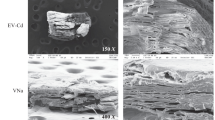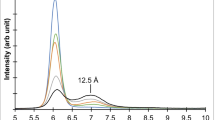Abstract
Sodium-lithium exchange equilibria between dilute aqueous chloride solutions and 0.2–62 µ Transvaal, South African vermiculite were studied at 25° and 50°C using a dialysis technique. The K content of the vermiculite was reduced to < 1% of the exchange capacity of 2·14 me/g by exhaustive extraction using Na-tetraphenylboron. The thermodynamic equilibrium constants and in turn the standard free energies and heats of exchange were evaluated from the equilibrium selectivity coefficients at the two temperatures. The standard entropy of exchange, ΔS°, was calculated according to the relationship ΔG° = ΔH° − TΔS°. Similar results were obtained for Na → Li and Li → Na exchange at 25°C, thus confirming the reversibility of the reaction.
Sodium preference increased with Na saturation of the vermiculite and equilibrium selectivity coefficients ranged from 6·0 to 22·0 at 25°C. In comparison, selectivity coefficients for Na-Li exchange on montmorillonite ranged from 1·0 to 2·0 and became smaller with increasing Na saturation. The standard free energy and heat of exchange on vermiculite at 25°C were −1444 and −5525 cal mole−1, respectively, resulting in a ΔS° value of −13·7 e.u. This relatively large entropy change is probably due to differences in ion hydration in the solution and surface phases.
Résumé
On a étudie les équilibres d'échange sodium-lithium entre des solutions de chlorures diluées et une vermiculite du Transwaal, Afrique du Sud dans les conditions suivantes: taille des particules: 0,2 à 62 µ, température 25 et 50°C, technique de l'échange, dialyse. La teneur en potassium de la vermiculite a été réduite à moins de 1% de la capacité d'échange—qui est 2,14 me/g—par une extraction exhaustive à l'aide du tétraphànylborate de sodium. Les constantes d'équilibre thermodynamique puis les énergies libres standard et les chaleurs d'échange ont été évaluées à partir des coefficients de sélectivité à l'équilibre aux deux températures. L'entropie standard d'échange, ΔS°, a été calculée par la relation ΔG° = ΔH° − TΔS°. Des résultats similaires ont été obtenus pour les échanges Na → Li et Li → Na, à 25°C, ce qui confirme la réversibilité de la réaction.
La préférence pour le sodium augmente avec le taux de saturation en Na de la vermiculite, et les coefficients de sélectivité à 25°C vont de 6,0 à 22,0. Par comparaison, les coefficients de sélectivité pour l'échange Na-Li sur la montmorillonite vont de 1,0 à 2,0 et diminuent quand la saturation en Na augmente. L'énergie libre standard et la chaleur d'échange avec la vermiculite sont respectivement de −1444 et −5525 cal mole−1, ce qui entraine un ΔS° de −13,7 u.e. Cette variation d'entropie relativememt importante est probablement due aux différences existant pour l'hydratation ionique entre la phase solution et la phase superficielle.
Kurzreferat
Natrium-Lithium Austauschgleichgewichte zwischen verdünnten wässrigen Chloridlösungen und 0,2 bis 62 µ Transvaal, südafrinkanischen Vermiculit wurden bei 25 und 50°C unter Verwendung einer Dialysentechnik studiert. Der K Gehalt des Vermiculit wurde unter Verwendung von Na-tetraphenylbor durch erschöpfende Extrahierung auf weniger als 1% der Austauschleistung von 2,14 me/g reduziert. Die thermodynamischen Gleichgewichtskonstanten, sowie die normalen freien Energien und Austauschwärmen wurden aus den Gleichgewichts-Selektivitätskoeffizienten bei den zwei Temperaturen bewertet. Die normale Austauschentropie S° wurde gemäss der Beziehung D° = H° − T S° berechnet. Ähnliche Ergebnisse wurden erhalten für Na → Li und Li → Na Austausch bei 25°C, wodurch die Reversibilität der Reaktion bestätigt wird.
Bevorzugung für Natrium nahm zu mit der Na-Sättigung des Vermiculits und die Gleichgewichts-Selektivitätskoeffizienten erstreckten sich von 6,0 bis 22,0 bei 25°C. Vergleichsweise erstreckten sich die Selektivitätskoeffizientan für Na-Li Austausch an Montmorillonit von 1,0 bis 2,0 und wurden kleiner mit zunchmender Na-Sättigung. Die normale freie Energie und Austauschwärme an Vermiculit bei 25°C waren −1444 bzw. −5525 cal mol−1, was einen ΔS° Wert von −13,7 e.u. ergibt. Diese verhältnismässig grosse Entrepieanderung ist wahrscheinlich eine Folge von unterschiedlicher Ion-Hydratisiertung in der Lösungsphase und an der Oberfläche.
Резюме
Натриево-литиевое обменное равновесие между разбавленными хлоридными растворами и фракцией 0,2-62 мк вермикулита из Трансвааля были изучены с использованием техники диализа. Содержание К в вермикулите было снижено до < 1 % обменной емкости или 2,14 мг/г тщательной экстракцией с помощью Ыа-тетрафенилбора. Константы термодинамического равновесия, а затем стандартные свободные энергии и теплоты обмена были определены по коэффициентам равновесной селективности для двух температур. Стандартная энтропия обмена Д8° была вычислена по равенству ДС° = ДН° — ТД8°. Сходные результаты были получены для обмена № → 1л и 1л -» Ыа при 25°, подтверждая обратимость реакции.
Избирательность для № возрастала с насыщением им вермикулита, коэффициенты равновесной селективности колебались от 6 до 22,0 при 25°. В сравнении с ними коэффициенты селективности для обмена №-1л на монтмориллоните составляли от 1,0 до 2,0 и уменьшались с возрастанием насыщения натрием. Стандартная свободная энергия и теплота обмена на вермикулите при 25° были равны соответственно — 1444 и — 5225 кал/моль-1, а Д8° — 13,7. Такое относительно большое изменение энтропии, вероятно, вызвано различиями в гидратации ионов в растворе и поверхностных фазах.
Similar content being viewed by others
References
Barshad, I. (1954) Cation exchange of micaceous minerals-I. Replaceability of the interlayer cations of vermiculite with ammonium and potassium ions: Soil Sci. 77, 463–472.
Bradley, W. F., Weiss, E. J. and Rowland, R. A. (1963) A glycol-sodium vermiculite complex: Clays and Clay Minerals 10, 117–122.
Brunauer, S. (1945) The adsorption of gasses and vapors. Physical Adsorption, Vol. 2. Princeton University Press, Princeton, New Jersey, p. 5.
Cloos, P., Fripiat, J. J., Poncelet, G. and Poncelet, A. (1965) Comparaison entre les propriétés d’échange de la montmorillonite et d’une résine vis-à-vis des cations alcalins et alcalino-terraux—II. Phénomène de sélectivité: Bull. Soc. Chim. Fr. 43, 215–219.
Eliason, J. R. (1966) Montmorillonite exchange equilibria with strontium-sodium-cesium: Am. Mineralogist 51, 324–335.
Gaines, G. L., Jr. and Thomas, H. C. (1953) Adsorption studies on clay minerals—II. A formulation of the thermodynamics of exchange adsorption: J. Chem. Phys. 21, 714–718.
Gast, R. G. (1969) Standard free energies of exchange for alkali metal cations on Wyoming bentonite: Soil Sci. Soc. Am. Proc. 33, 37–41.
Gast, R. G. (1970) Alkali metal cation exchange equilibria on Chambers montmorillonite: Soil Sci. Soc. Am. Proc. In review.
Gast, R. G., Van Bladel, R. and Deshpande, K. B. (1969) Standard heats and entropies of exchange for alkali metal cations on Wyoming bentonite: Soil Sci. Soc. Am. Proc. 33, 661–664.
Howery, D. G. and Thomas, H. C. (1965) Ion exchange on the mineral clinoptilolite: J. Phys. Chem. 69, 531–537.
Jenny, H. (1932) Studies on the mechanism of ionic exchange in colloidal aluminum silicates: J. Phys. Chem. 36, 2217–2258.
Klobe, W. D. and Gast, R. G. (1970) Conditions affecting cesium fixation and sodium entrapment in hydro-biotite and vermiculite: Soil Sci. Soc. Am. Proc. 34, 746–750.
Laudelout, H., Van Bladel, R., Bolt, G. H. and Page, A. L. (1968) Thermodynamics of heterovalent cation exchange reactions in a montmorillonite clay. Trans. Faraday Soc. 64, 1477–1488.
Lewis, R. J. and Thomas, H. C. (1963) Adsorption studies on clay minerals — Vili. A consistency test of exchange sorption in the systems sodium-cesium-barium montmorillonite: J. Phys. Chem. 67, 1781–1783.
Martin, H. and Laudelout, H. (1963) Thermodynamique de l’échange des cations alcalins dans les argiles: J. Chim. Phys. 76, 1086–1099.
Robinson, R. A. and Stokes, R. H. (1955) Electrolyte Solutions. Butterworths, London, p. 69.
van Olphen, H. (1965) Thermodynamics of interlayer adsorption of water in clays: J. Colloid. Sci. 20, 822–837.
Wild, A. and Keay, J. (1964) Cation exchange equilibria with vermiculite: J. Soil Sci. 15, 135–144.
Author information
Authors and Affiliations
Rights and permissions
About this article
Cite this article
Gast, R.G., Klobe, W.D. Sodium-Lithium Exchange Equilibria on Vermiculite at 25° and 50°C. Clays Clay Miner. 19, 311–319 (1971). https://doi.org/10.1346/CCMN.1971.0190507
Received:
Published:
Issue Date:
DOI: https://doi.org/10.1346/CCMN.1971.0190507




